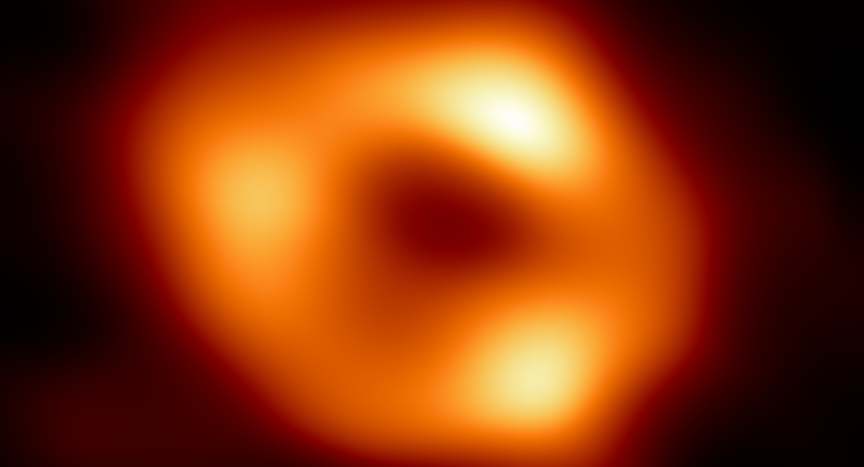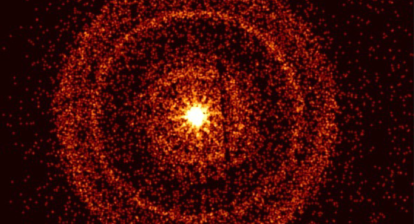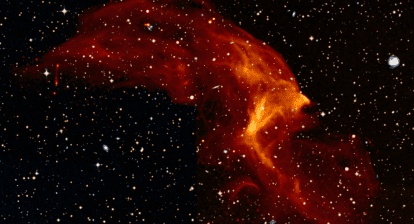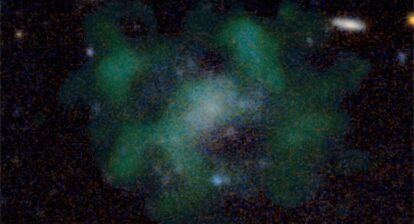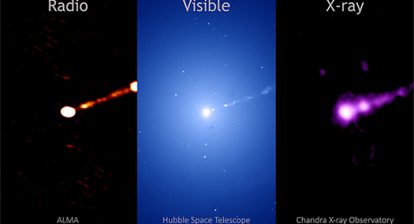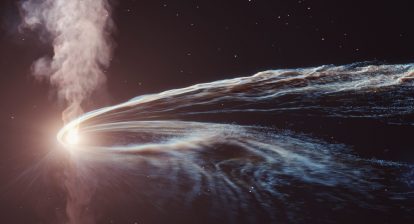The Event Horizon Telescope Collaboration team has done it again! They have captured the first ever image of the black hole at the centre of our own Milky Way Galaxy. This one is called Sagittarius A* (or Sag A*), it is four million times the mass of our Sun and about 27,000 light-years away from us.
We can’t see the black hole of course. It’s too dark and its gravity does not allow light to escape for us to be able to see it. We do see a central dark region surrounded by glowing gas from the material being sucked into it. This bright area is around 60 million km, or 40 million miles, across. (What are black holes?)
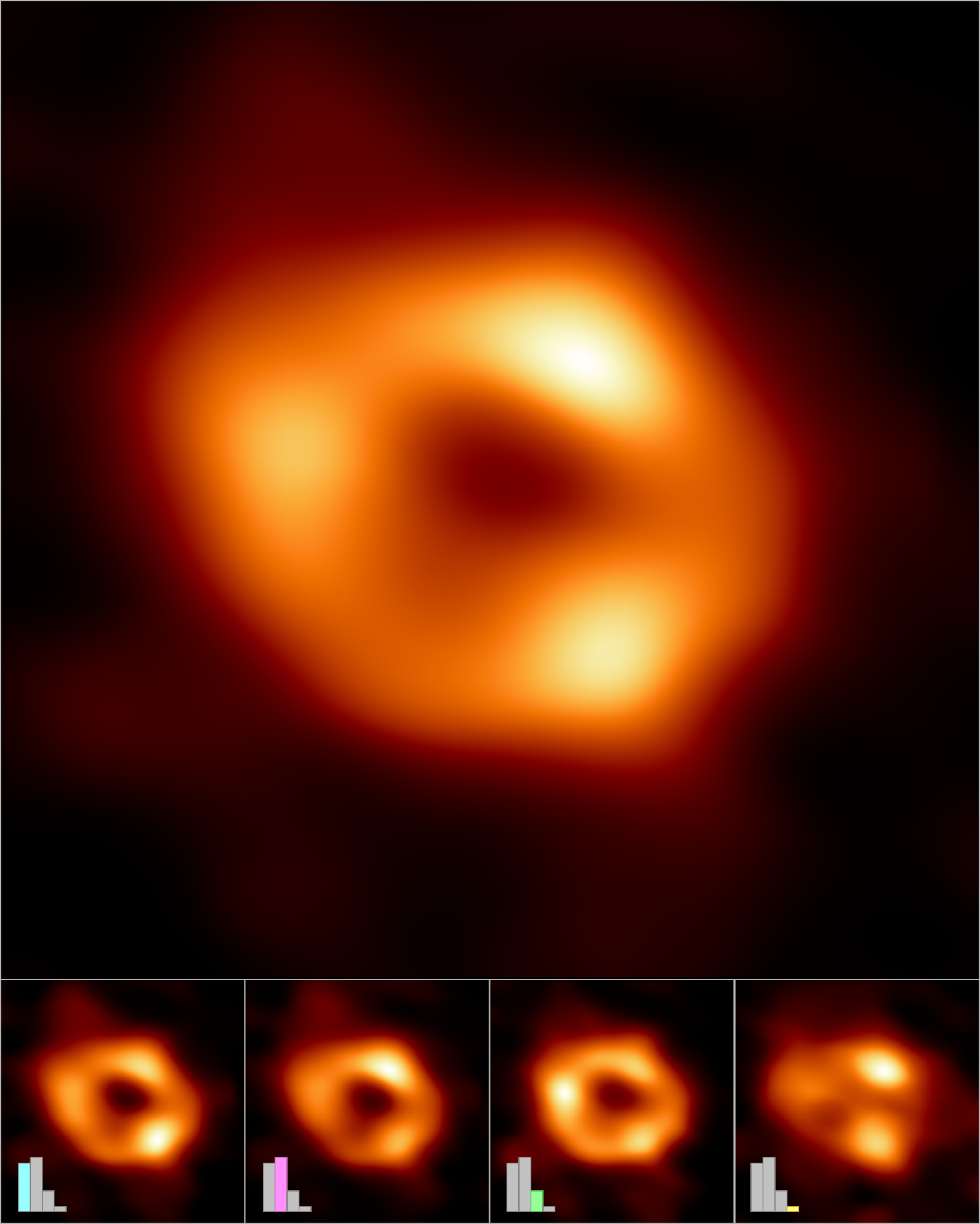
The Event Horizon Telescope (EHT) Collaboration has created a single image (top frame) of the supermassive black hole at the centre of our galaxy, called Sagittarius A* (or Sgr A* for short), by combining images extracted from the EHT observations. Credit Event Horizon Telescope Collaboration
Our first ever view of what a black hole looked like was in April 2019, when a direct image of a supermassive black hole and its vicinity was revealed through observations made by the Event Horizon Telescope Collaboration. This super-massive black hole lives at the center of a supergiant galaxy called Messier 87 (fifty five million light years away from Earth). That image confirms scientists’ predictions of black holes and their event horizon.

Image of a black hole at the centre of galaxy M87 and its event horizon, taken by the Event Horizon telescope in 2019. Photograph: Event Horizon Telescope Collaboration/EPA
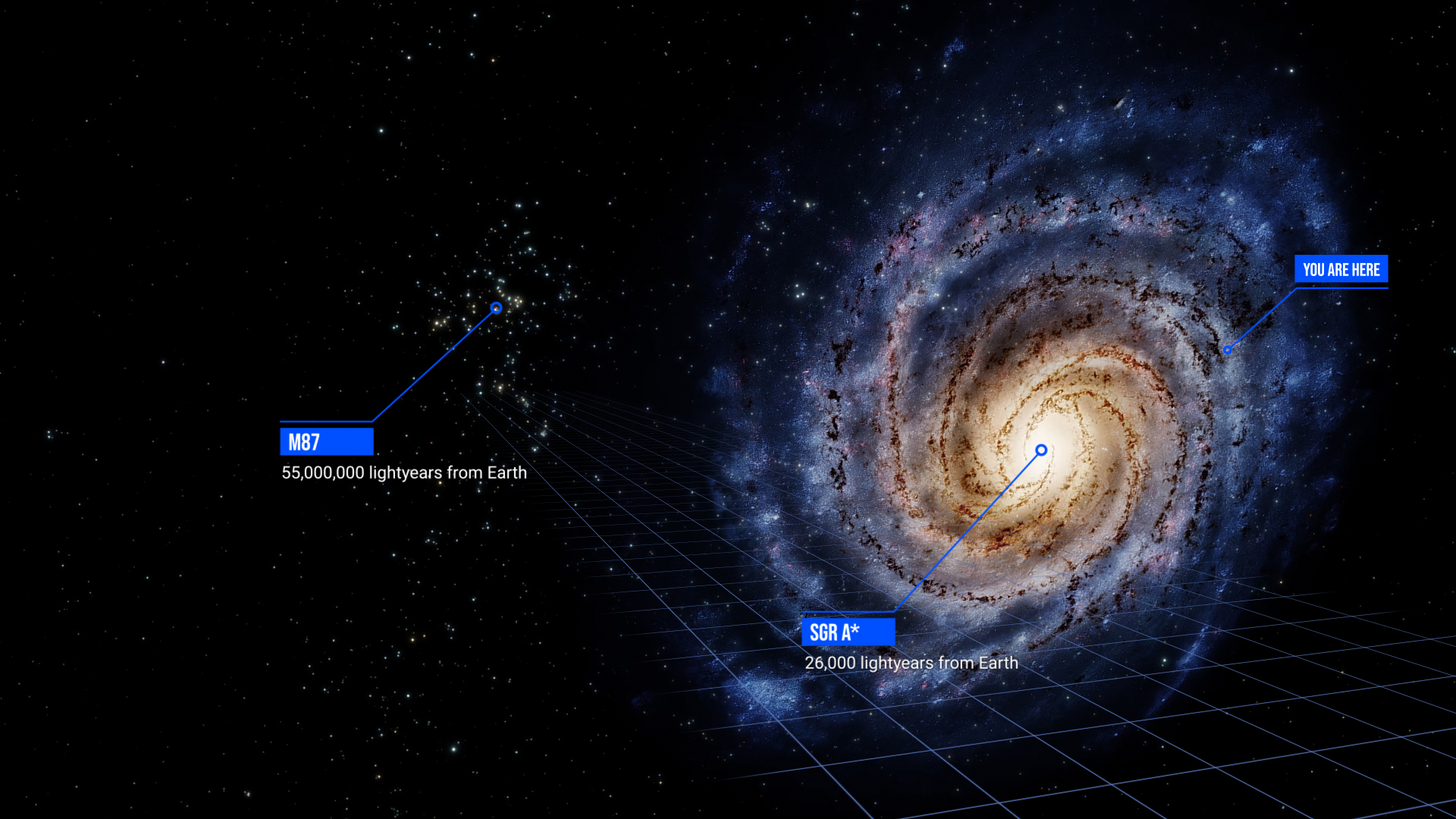
While Sgr A* is the supermassive black hole in the center of our own galaxy, the supermassive black hole M87 resides more than 55,000,000 lightyears from Earth. Credit: Image: National Science Foundation/Keyi “Onyx” Li
As predicted by Einstein’s Theory of General Relativity, the four million solar mass black hole’s strong gravity is bending light and creating a shadow-like dark central region surrounded by a bright ring-like structure.
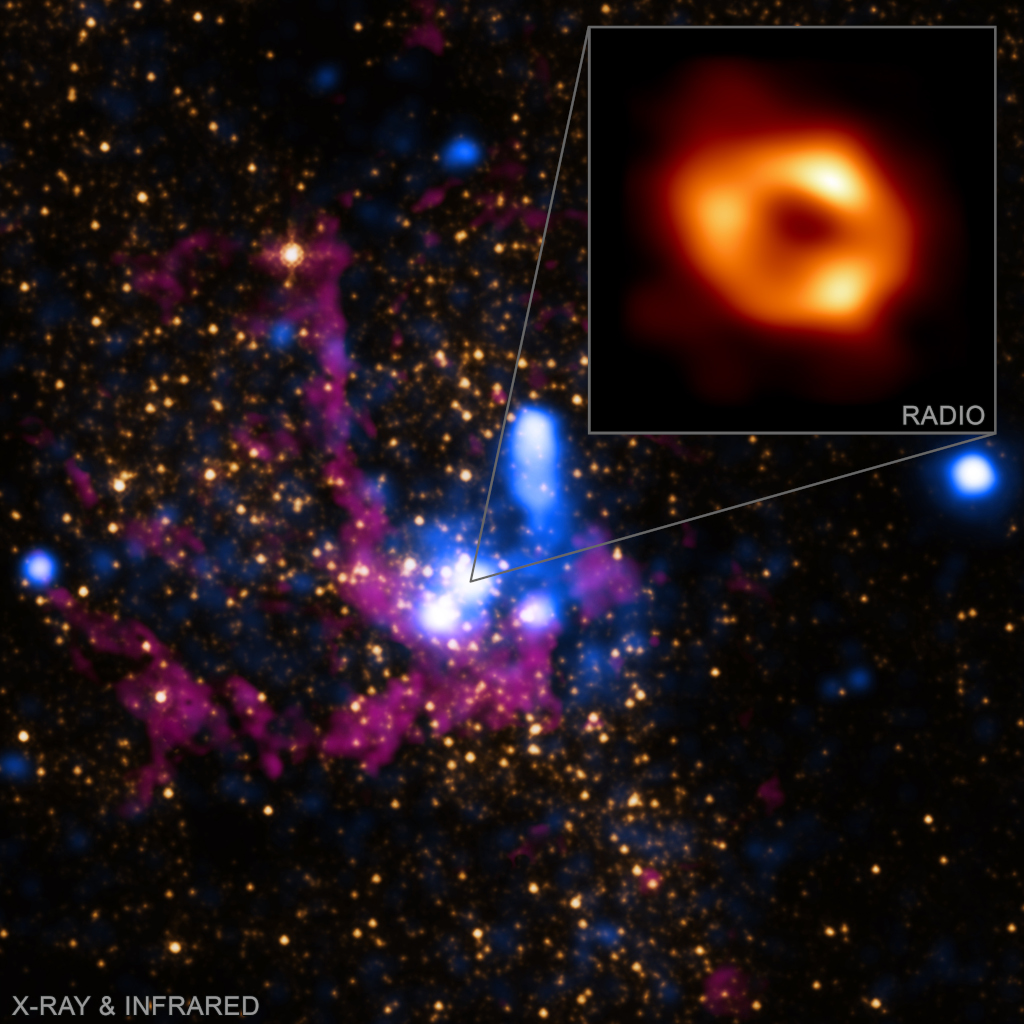
The main panel image shows the X-ray data from Chandra and infrared data from Hubble. While the main panel is about 7 light-years across, the Event Horizon Telescope inset image itself spans a mere 10 light-minutes at the center of our galaxy, some 27,000 light-years away. Image Credit: X-ray – NASA/CXC/SAO, IR – NASA/HST/STScI; Inset: Radio – Event Horizon Telescope Collaboration
And here is the video that zooms into the centre of the galaxy towards the black hole by European Southern Observatory:
Below is what the EHT Collaboration wrote in their statement:
“The image is a long-anticipated look at the massive object that sits at the very centre of our galaxy. Scientists had previously seen stars orbiting around something invisible, compact, and very massive at the centre of the Milky Way. This strongly suggested that this object — known as Sagittarius A* (Sgr A*, pronounced “sadge-ay-star”) — is a black hole, and today’s image provides the first direct visual evidence of it.
Although we cannot see the black hole itself, because it is completely dark, glowing gas around it reveals a telltale signature: a dark central region (called a “shadow”) surrounded by a bright ring-like structure. The new view captures light bent by the powerful gravity of the black hole, which is four million times more massive than our Sun.
“We were stunned by how well the size of the ring agreed with predictions from Einstein’s Theory of General Relativity,” said EHT Project Scientist Geoffrey Bower from the Institute of Astronomy and Astrophysics, Academia Sinica, Taipei. “These unprecedented observations have greatly improved our understanding of what happens at the very centre of our galaxy, and offer new insights on how these giant black holes interact with their surroundings.” The EHT team’s results are being published today in a special issue of The Astrophysical Journal Letters.
Because the black hole is about 27,000 light-years away from Earth, it appears to us to have about the same size in the sky as a donut on the Moon. To image it, the team created the powerful EHT, which linked together eight existing radio observatories across the planet to form a single “Earth-sized” virtual telescope [1]. The EHT observed Sgr A* on multiple nights, collecting data for many hours in a row, similar to using a long exposure time on a camera.
The breakthrough follows the EHT collaboration’s 2019 release of the first image of a black hole, called M87*, at the centre of the more distant Messier 87 galaxy.
The two black holes look remarkably similar, even though our galaxy’s black hole is more than a thousand times smaller and less massive than M87* [2]. “We have two completely different types of galaxies and two very different black hole masses, but close to the edge of these black holes they look amazingly similar,” says Sera Markoff, Co-Chair of the EHT Science Council and a professor of theoretical astrophysics at the University of Amsterdam, the Netherlands. “This tells us that General Relativity governs these objects up close, and any differences we see further away must be due to differences in the material that surrounds the black holes.”
This achievement was considerably more difficult than for M87*, even though Sgr A* is much closer to us. EHT scientist Chi-kwan (‘CK’) Chan, from Steward Observatory and Department of Astronomy and the Data Science Institute of the University of Arizona, US, explains: “The gas in the vicinity of the black holes moves at the same speed — nearly as fast as light — around both Sgr A* and M87*. But where gas takes days to weeks to orbit the larger M87*, in the much smaller Sgr A* it completes an orbit in mere minutes. This means the brightness and pattern of the gas around Sgr A* was changing rapidly as the EHT Collaboration was observing it — a bit like trying to take a clear picture of a puppy quickly chasing its tail.”
The researchers had to develop sophisticated new tools that accounted for the gas movement around Sgr A*. While M87* was an easier, steadier target, with nearly all images looking the same, that was not the case for Sgr A*. The image of the Sgr A* black hole is an average of the different images the team extracted, finally revealing the giant lurking at the centre of our galaxy for the first time.
The effort was made possible through the ingenuity of more than 300 researchers from 80 institutes around the world that together make up the EHT Collaboration. In addition to developing complex tools to overcome the challenges of imaging Sgr A*, the team worked rigorously for five years, using supercomputers to combine and analyse their data, all while compiling an unprecedented library of simulated black holes to compare with the observations.
Scientists are particularly excited to finally have images of two black holes of very different sizes, which offers the opportunity to understand how they compare and contrast. They have also begun to use the new data to test theories and models of how gas behaves around supermassive black holes. This process is not yet fully understood but is thought to play a key role in shaping the formation and evolution of galaxies.
“Now we can study the differences between these two supermassive black holes to gain valuable new clues about how this important process works,” said EHT scientist Keiichi Asada from the Institute of Astronomy and Astrophysics, Academia Sinica, Taipei. “We have images for two black holes — one at the large end and one at the small end of supermassive black holes in the Universe — so we can go a lot further in testing how gravity behaves in these extreme environments than ever before.”
Progress on the EHT continues: a major observation campaign in March 2022 included more telescopes than ever before. The ongoing expansion of the EHT network and significant technological upgrades will allow scientists to share even more impressive images as well as movies of black holes in the near future.”
[UPDATE]:
Then in March 2024, the Event Horizon Telescope (EHT) collaboration, captured a new view of the massive object at the center of our Galaxy: how it looks in polarized light. This is the first time astronomers have been able to measure polarization, a signature of magnetic fields, this close to the edge of Sagittarius A*. This image shows the polarized view of the Milky Way black hole. The lines mark the orientation of polarization, which is related to the magnetic field around the shadow of the black hole.
“What we’re seeing now is that there are strong, twisted, and organized magnetic fields near the black hole at the center of the Milky Way galaxy,” said Sara Issaoun, NASA Hubble Fellowship Program Einstein Fellow at the Center for Astrophysics | Harvard & Smithsonian and co-lead of the project. “Along with Sgr A* having a strikingly similar polarization structure to that seen in the much larger and more powerful M87* black hole, we’ve learned that strong and ordered magnetic fields are critical to how black holes interact with the gas and matter around them.”

Sagittarius A in Polarized light. Image Credit: EHT Collaboration
